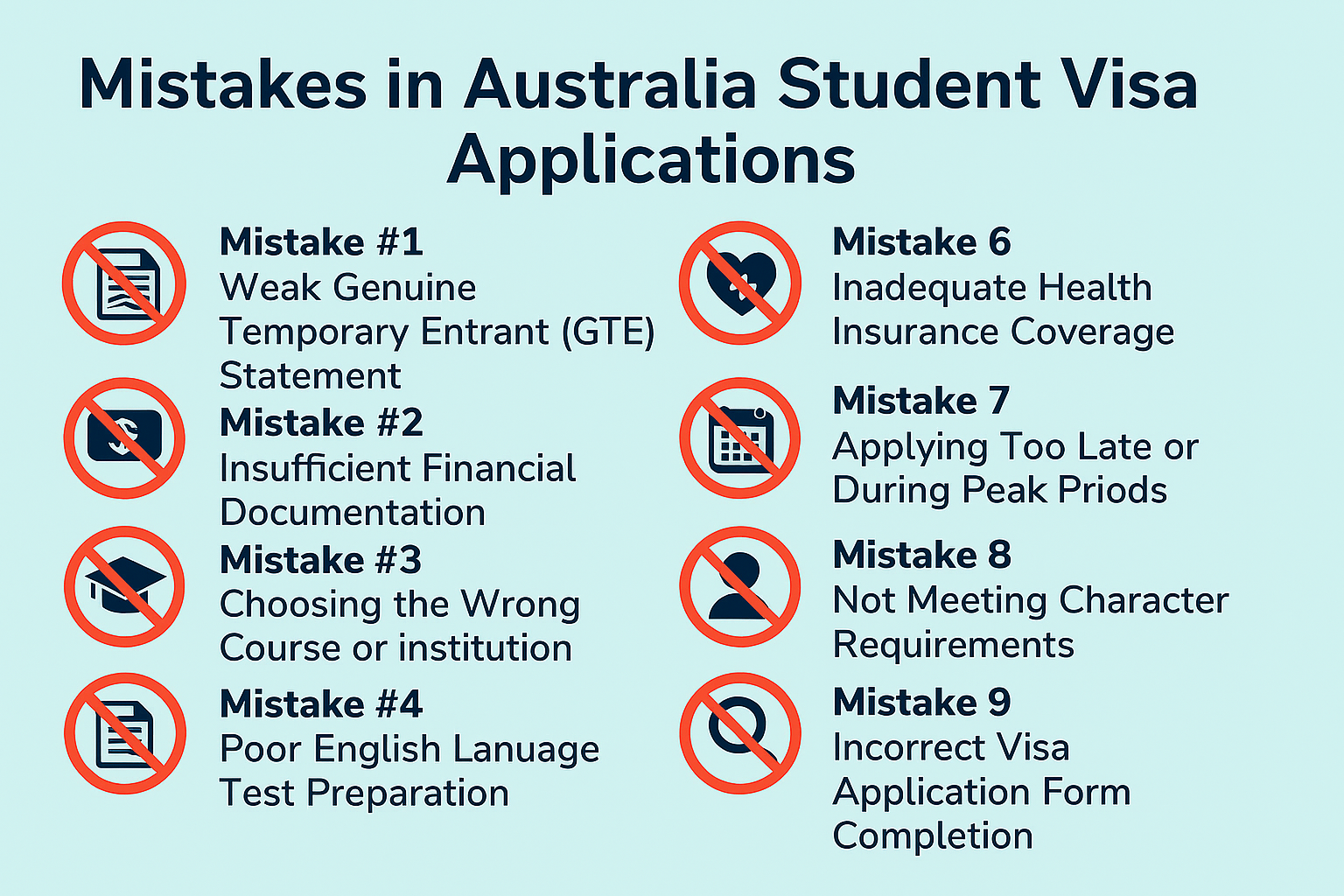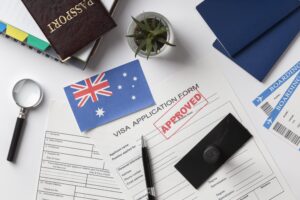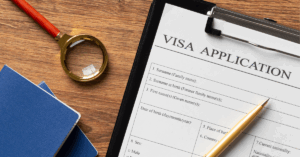
Getting an Australian student visa approved can feel like a big hurdle, but it’s the foundation of your study plans. Australia is one of the most popular destinations for international students today, thanks to its universities, lifestyle, and promising prospects. Simultaneously, the process is strict. Approximately 15% of student visa applications are rejected annually, and in most instances, it’s not that people are not appropriate, but rather due to minor but expensive errors.
If you’re preparing your Subclass 500 visa application or planning to enter a leading university, it’s essential to understand the most common mistakes students make. Avoiding these mistakes may get you out of being behind schedule or even rejected.
At Bombay Migrations, we guide students through every step of the Australian student visa process.
Why Australian Student Visa Applications Get Rejected
The Home Affairs Department examines each case closely. To win, you must show them that you are a true, genuine temporary entrant (GTE). That is, you have to assure them that you are entering Australia for study and will go back home once your studies are complete.
What is a Genuine Temporary Entrant (GTE) statement?
A Genuine Temporary Entrant (GTE) statement is a written explanation you provide to the Department of Home Affairs when applying for an Australian student visa. It’s your chance to show that you are coming to Australia mainly to study, and that you intend to return home after completing your course.
Apart from this, you will also be judged upon your qualifications, your command of English, and your resources. Visa officers want to see that you can handle your education costs as well as your living needs during your time abroad.
The good thing is that most of the issues causing rejection could be avoided if you prepare and present proper evidence.
Mistake #1: Weak Genuine Temporary Entrant (GTE) Statement
Your GTE statement is amongst the strongest determinants of your visa application outcome. Sadly, that’s also where most students make mistakes. A copied or ambiguous statement is among the strongest red flags for officers examining applications.
Common errors students commit:
- Copy-pasting generic statements from the internet
- Providing no obvious reason for studying in Australia instead of elsewhere
- Not linking the selected course to career goals
- Giving very minimal information about correspondence with the home country
- Being too concise while explaining reasons and circumstances
How to strengthen your GTE statement:
Frame it as relating your own story. Describe why Australia, why this college or university specifically, and why this program. Be detailed: mention course modules, academic facilities, or professional opportunities that are worth the program. In contrast, refer to family or work ties back home to show that you genuinely intend to return. A good GTE is personal, detailed, and interesting, and can be the difference. Your GTE statement is one of the strongest factors in the outcome of your visa application. Unfortunately, it’s also where many students go wrong. A vague or copied statement is one of the biggest red flags for officers reviewing applications.
Mistake #2: Insufficient Financial Documentation
A significant 38% of visa refusals happen because of financial proof issues. Authorities want clear evidence that you can fund both tuition and living costs while studying in Australia.
Financial documentation mistakes include:
- Sudden, unexplained deposits in bank accounts
- Submitting fake or exaggerated financial documents
- Not showing sufficient funds to cover study and living expenses
- Missing sponsor income verification papers
- Ignoring Australia’s specific financial requirements
How to meet requirements:
Provide genuine bank statements covering 3–6 months. If you’re sponsored, include complete income documents such as salary slips, tax returns, and employment letters. Be mindful of the official requirement, tuition plus around AUD 21,000 per year for living costs. Also note that the VAC for Student visas (subclass 500) increased in July 2025 from $1,600 to $2,000 for the main applicant.
Mistake #3: Choosing the Wrong Course or Institution
Another common reason for Australia student visa rejection is a mismatch between the applicant’s educational or professional background and the chosen course.
Course selection mistakes include:
- Choosing a course that does not connect with your previous education or professional background.
- Applying to institutions not registered with CRICOS(Commonwealth Register of Institutions and Courses of Overseas Students)
- Downgrading qualifications (e.g., a PhD holder applying for a diploma)
- Not understanding course content or career outcomes
- Submitting applications for courses that don’t connect.
Best approach:
Choose a course that naturally progresses from your current qualifications or experience. Ensure your selected course and institution are officially listed on the CRICOS register. Research course details thoroughly and be ready to explain how it fits your career path.
Mistake #4: Poor English Language Test Preparation
Australia accepts multiple English proficiency tests, but many students fail to meet the minimum score or submit invalid results.
Common English test mistakes:
- Taking the wrong test type for your course
- Scoring below the minimum entry requirements
- Submitting expired results (usually valid for 2 years)
- Ignoring different score requirements for vocational vs. university programs
- Forgetting to send official scores to the institution and authorities
Meeting English requirements:
Recognised language tests are IELTS Academic, TOEFL iBT, PTE Academic, and Cambridge English. For most universities, the standard is IELTS 6.5 overall with no band below 6.0, though vocational programs may vary. Prepare thoroughly with practice tests or coaching if needed, and ensure scores are submitted correctly.
Mistake #5: Incomplete or Incorrect Documentation
Even minor errors in documentation can cause immediate rejection. Immigration officers are strict about consistency and completeness.
Documentation errors include:
- Different name spellings across documents
- Missing certified translations for non-English records
- Using expired or outdated certificates
- Incorrect passport details on forms
- Missing health reports from approved physicians
How to avoid issues:
Follow the Department of Home Affairs checklist closely. Double-check that details match exactly across every document. Translate and certify non-English documents. Book health checks early and only with approved panel doctors. Keep both digital and paper copies for reference.
Mistake #6: Inadequate Health Insurance Coverage
Every international student is required to hold Overseas Student Health Cover (OSHC) throughout their stay. Failing to secure proper coverage often leads to refusal.
Insurance mistakes include:
- Buying OSHC for a shorter duration than your course
- Purchasing from unapproved providers
- Not including coverage for dependents, if applicable
- Forgetting to attach the OSHC confirmation to your application
How to get it right:
Choose government-approved providers such as Bupa, Allianz Care, or Medibank. Ensure your policy starts before your arrival and covers your full study period plus additional work rights. Attach the OSHC proof to your visa application.
Mistake #7: Applying Too Late or During Peak Periods
Timing matters. Submitting your visa application too close to the start date can cause unnecessary delays.
Timing mistakes include:
- Applying right before the course begins
- Ignoring the time required for medicals and clearances
- Submitting during peak season (October–February)
- Missing enrollment deadlines due to processing delays
Best practice:
Apply as soon as you get your Confirmation of Enrollment (CoE). Make sure to submit your application at least 8 to 10 weeks ahead of your planned departure. The processing period is generally around 4–6 weeks, though it may extend during peak times.
Mistake #8: Not Meeting Character Requirements
Australia enforces strict character requirements for visa applicants. Failure to declare past issues can result in rejection.
Character-related mistakes include:
- Not declaring past visa refusals or cancellations
- Missing police clearances from required countries
- Hiding criminal history or immigration issues
- Providing false or misleading information
How to comply:
Police checks are required from all countries where you have resided for at least a year after reaching 16 years of age. Be truthful about your history. Provide statutory declarations if necessary. Remember, authorities have access to international records.
Mistake #9: Incorrect Visa Application Form Completion
The online application form may look simple, but small mistakes can have serious consequences.
Form mistakes include:
- Entering inconsistent details in different sections
- Leaving required fields empty
- Uploading files in the wrong formats
- Forgetting to review before submission
How to ensure accuracy:
Fill the form carefully and consistently. Save your progress regularly. Upload documents in approved formats. Review everything twice, and if possible, have someone else check it before submission.
Mistake #10: Inadequate Course Preparation Research
Some students apply without a clear understanding of their course, which weakens their application.
Research mistakes include:
- Not knowing the course structure or curriculum
- Weak explanation of how it connects to career goals
- Limited knowledge about the Australian education system
- No research into job opportunities post-study
How to prepare properly:
Research your course thoroughly. Learn about curriculum, faculty, and industry links. Understand why the institution stands out. Be ready to explain how the course supports your career growth.
Australia-Specific Requirements to Keep in Mind
CRICOS registration: Make sure your institution and course are CRICOS-registered.
Work permissions: Student visa holders can work part-time, up to 48 hours per fortnight during classes, and full-time when on official breaks.
Health examinations: Required if you’re from certain countries or studying health-related programs.
Biometrics: Some applicants must submit biometrics at approved centres.
Course progress: You must maintain attendance and academic performance.
Red Flags That Lead to Rejection
Immigration officers look for warning signs such as:
- Unexplained gaps in education or employment
- Financial sponsors with unclear income sources
- Previous immigration violations
- Course choices that don’t align with career goals
- Health conditions requiring extensive treatment
Professional Help and Resources
While many students manage independently, consider professional guidance if you have:
- Complex financial sponsorships
- Previous visa rejections
- Long education or work gaps
- Health conditions impacting eligibility
- Tight application deadlines
Registered migration agents can help address complicated cases.
Final Tips for a Successful Australia Student Visa Application
Your visa success largely depends on attention to detail and genuine intent. Apply early, organise your documents carefully, and be honest in every statement. Remember, Australian student visa authorities value transparency and well-prepared applications.
With proper planning and by avoiding these common mistakes, you’ll be on your way to approval and an exciting educational journey in Australia.
If you’re planning to study in Australia and want expert guidance on your student visa, contact us today for personalised support.

